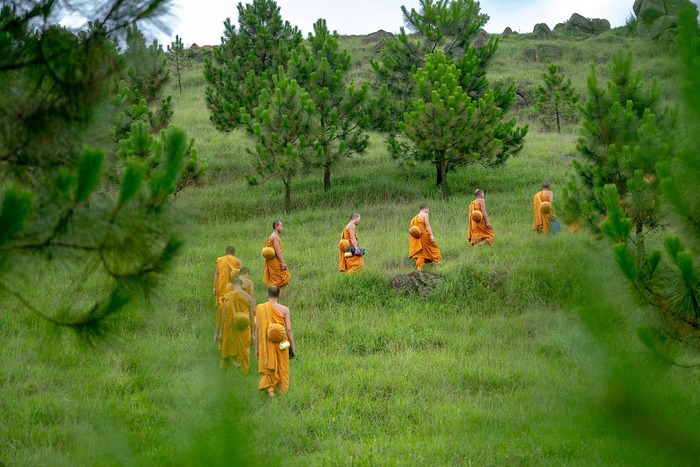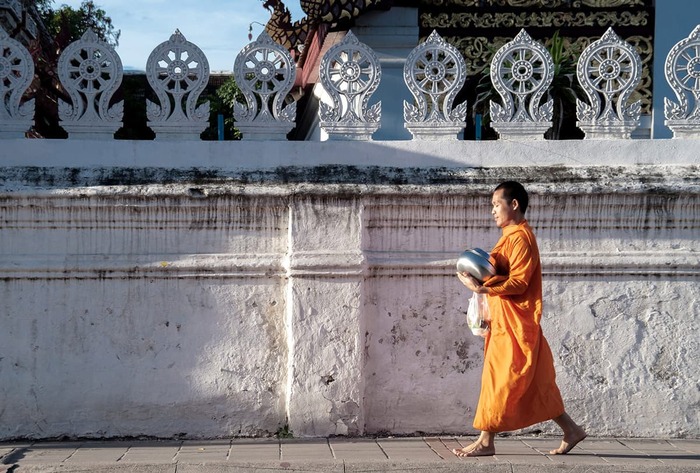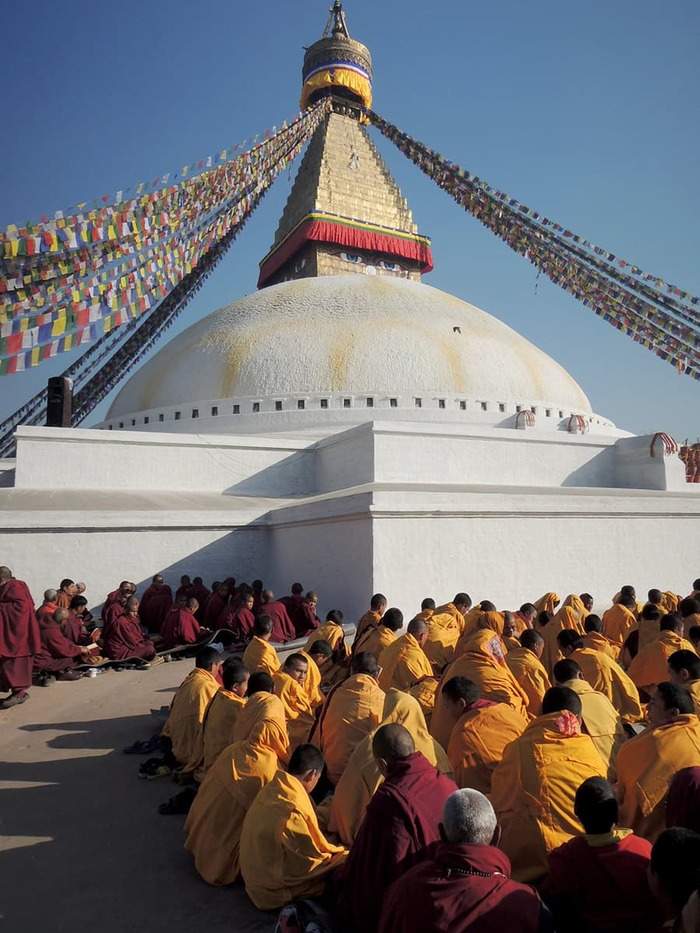
Origins of the Sangha
After the Buddha became enlightened, the Sutra of the Wheel of Dharma or Dharmachakrapravartana Sutra tells us that he gave his first teaching, on the four noble truths, to five former friends alongside whom he had practiced asceticism for several years. During this teaching, all five of the ascetics became his disciples, and among them, Kaundinya attained the state of an arhat, a liberated being. A few days later, while teaching on the voidness of the self, or how the self cannot exist in impossible ways, the other ascetics also all attained arhatship. These five disciples thus became the first members of the Sangha, or the first Buddhist monks.
The Buddha then spent the rest of his life – around 45 years in total – spreading the Dharma teachings he had discovered, while his disciples also travelled to villages and towns across the northern Indian plains to spread the Buddha’s message themselves. Quickly, the Buddha attracted many followers, hailing from across the social spectrum: other spiritual teachers, kings and queens, farmers and butchers, and so on. While the majority of disciples didn’t want to renounce worldly life, those who wished to leave lay life and join the Sangha were welcome to. The lay disciples, who continued to work and marry, supported the Sangha with food and clothing.
Over time, as more and more people formally joined the Buddha, it became necessary to create rules for the disciples to abide by in order to create a harmonious spiritual community. Rules were formulated, as and when needed and through trial and error, in response to incidents with undesirable outcomes occurring within the Sangha. By the end of the Buddha’s life, there were several hundred rules for the monks and nuns.

Ordination of Women
At the beginning, the Buddha only admitted men into the Buddhist order. Five years after the establishment of the order of monks, the Buddha’s aunt Mahaprajapati Gautami requested the Buddha to ordain her as a nun, but he refused. Yet, Mahaprajapati was undaunted and decided, along with 500 other women, to shave their heads and don yellow robes, and follow the Buddha.
Mahaprajapati made two more requests to the Buddha, and each time the Buddha refused to ordain them. On the fourth occasion, the Buddha’s cousin Ananda interceded on her behalf, asking whether women have the same capacity as men to proceed along the spiritual path and attain enlightenment, to which the Buddha replied affirmatively. Ananda then suggested that it would be good for women to become nuns, and the Buddha went ahead and allowed the ordination of female disciples.
Conventional Sangha and Arya Sangha
Usually, the term Sangha is used to refer to these two groups of bhikshus and bhikshunis, the nuns and monks who follow the Buddha’s teachings. The term bhikshu actually means “beggar,” and was used because the ordained community were supposed to renounce most material goods and wander from place to place, depending upon others for food. A minimum of four fully ordained or novice monks or nuns, whatever the level of their awareness or realization, is required to form a Sangha. We call this the conventional Sangha. There is also the arya Sangha, which refers to individuals, ordained or not, who have actually attained some of the realizations of the Dharma path.
It is important to make a distinction between the conventional Sangha and the arya Sangha. While there are many excellent ordinary monks and nuns, there can also be those who are just as emotionally disturbed as we are – and that might make us question why we should take refuge in them. Thus, as one of the Three Jewels, it is the arya Sangha that is the true jewel that we take refuge in. They are the ones who can genuinely help us to go in the right direction.

Qualities of the Sangha
So, what kind of qualities does the Sangha have that we want to develop ourselves?
- When they teach, they don’t just repeat what they’ve learned from books. They speak from their own authentic experience – and this is really inspiring.
- Their only wish is to help others, and they practice what they preach. Think of a smoker scolding us about the dangers of smoking, we will really wonder why we should follow their advice, right? For that reason, the Sangha is always sincere in what they do, so we can really trust them.
- When we spend time with bad company, often we don’t even realize how much we pick up their bad qualities ourselves. Similarly, if we hang out with good friends, without even much effort, we quickly gain good qualities. So, the Sangha has a very good influence on us to improve our Dharma practice.
The Importance of the Sangha
The Buddha passed away some 2500 years ago, leaving behind his teachings – the Dharma – for us to practice. And this is what Buddhism is all about. But in order for us to practice well, we need reliable examples, people who have actually learned and studied and practiced the Buddha’s teachings and attained some of its goals, to help and guide us. The community of such people is the Sangha.
Nowadays, we often turn to celebrities as our role models: actors and actresses, models, singers, and sportspeople. But these people have their own problems, right? We know that, in their private lives, they’re often a mess! Not only that, but when we become obsessed with celebrities and their lives, it usually only leads us to gossip with our friends and grasp even more than usual at material attachments; these activities don’t really bring ourselves or others any true benefit or happiness. The Sangha, on the other hand, are people who have already gotten rid of some level of their problems – isn’t that great! – and are working to get rid of the rest. Doesn’t it make sense to follow their example if we want to get rid of our own problems too?
It is entirely thanks to the Sangha that today, in our modern world, we have the wonderfully preserved teachings of the Buddha passed down from generation to generation. The Sangha inspire us to look beyond our immediate problems and see that there is a path that takes us completely out of all suffering. And they don’t only inspire us, they guide, encourage, and support us every step of the way. This is why it is sometimes said that without the Sangha, there is no Buddhism.
Summary
How can we choose a good role model in life? Although we might not meet a real member of the Sangha – someone with real attainments, an arya Sangha – still, we can meet people who are more experienced in the Dharma and get inspiration from them. Seeing their examples, we become encouraged to follow in their footsteps.
It is through the dedication of Buddhist monks and nuns, the conventional Sangha, that the Dharma managed to spread throughout the world. Just like the Buddha is likened to a doctor and the Dharma to medicine, the Sangha are like nurses who encourage and guide us on the path, as we work towards freedom from all of our problems forever.